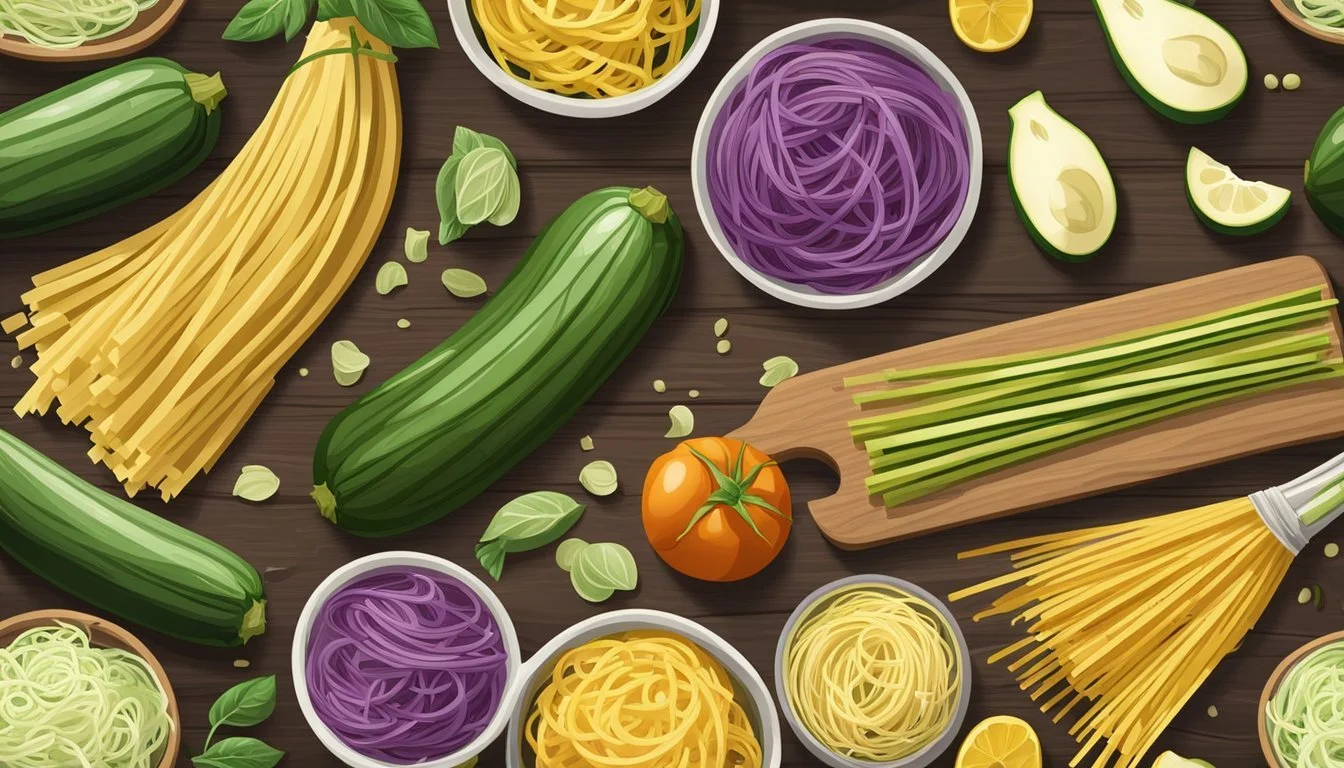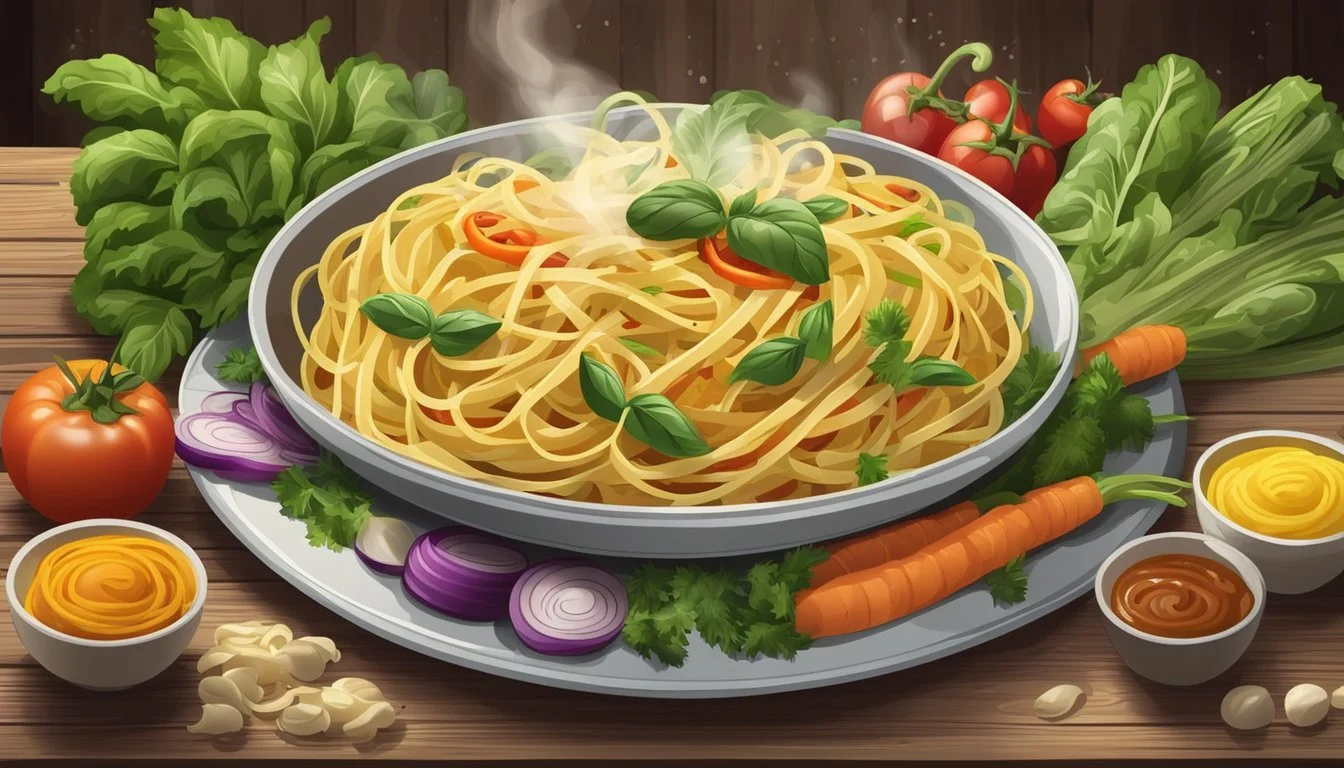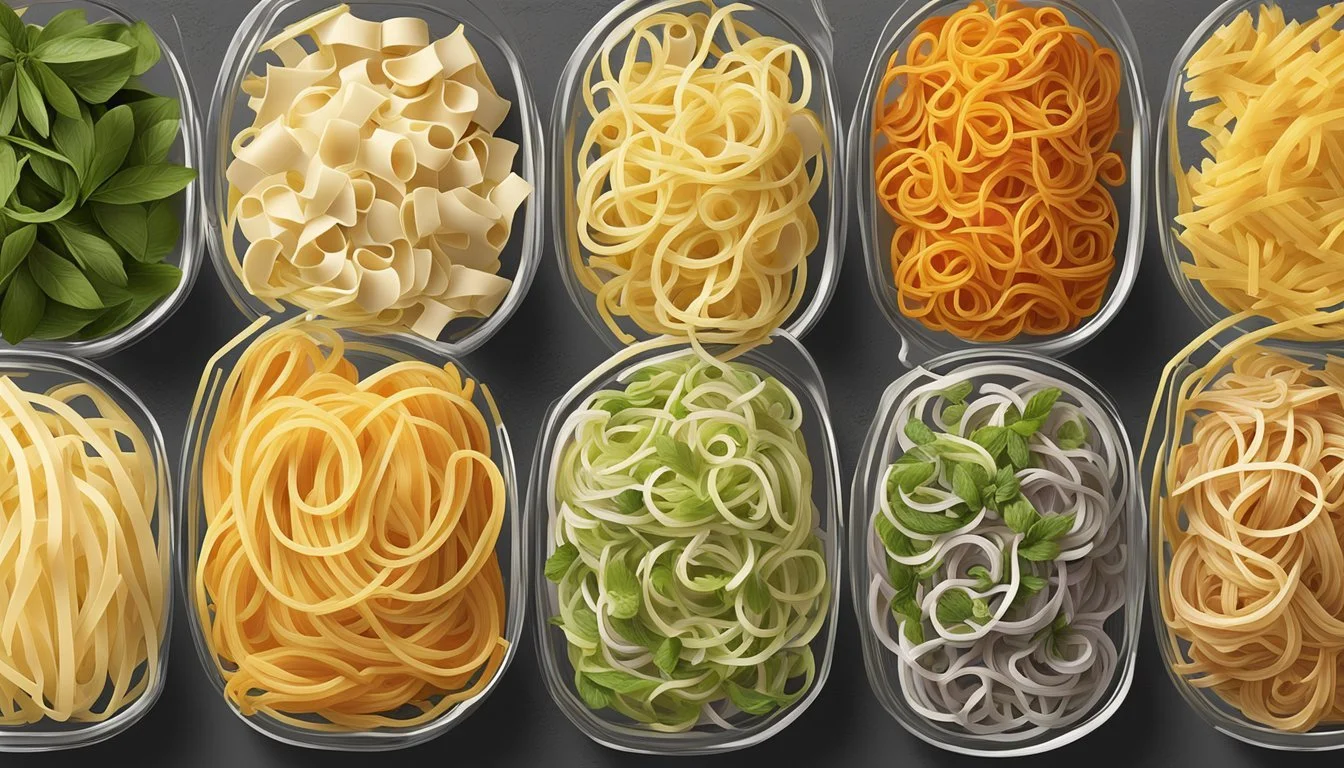Linguine Pasta Substitutes
Top Alternatives for Classic Italian Dishes
Linguine, a popular type of pasta (What wine goes well with pasta?) with long, flat strands, is a staple in many dishes, serving as the foundation for an array of sauces and ingredients. While it holds a beloved place in culinary traditions, there are times when a substitute is necessary, whether due to dietary restrictions, texture preferences, or simply the need to innovate within the kitchen. The exploration of pasta substitutes not only caters to the diverse needs of diners but also opens up a realm of creative possibilities for both home cooks and professional chefs.
Several alternatives to traditional linguine pasta offer similar characteristics, ensuring that the essence of a dish is preserved. Fettuccine noodles are frequently recommended due to their comparable flat and ribbon-like shape that makes them ideal for recipes that require the pasta to be well-coated with sauce. Spaghetti, another classic option, and capellini, also known as angel hair pasta, present a slightly thinner profile and are usually cooked to an al dente texture within eight to ten minutes. These pasta varieties are exemplary in mimicking the texture and behavior of linguine in various recipes.
Moreover, for those seeking healthier options or catering to specific dietary needs, the market for pasta alternatives has expanded significantly. Spiralized vegetables, for instance, provide a nutritious and low-carb option while maintaining a semblance of the pasta-eating experience. This versatility in choice allows individuals to enjoy a dish that stays true to the spirit of a linguine-based meal while tailoring the ingredients to their unique preferences or health considerations.
Understanding Linguine
Linguine is a staple of Italian cuisine, renowned for its unique flavor and texture. This section explores its origins and how it is typically utilized in various dishes.
Origin and Characteristics
Originating from the coastal regions of Liguria, Italy, linguine is a type of pasta akin to flat spaghetti, characterized by its long, elliptical shape. Made primarily from durum wheat flour, it has a subtle flavor that complements a wide range of ingredients. Linguine's texture is firm and has a notable ability to absorb sauces, which is why it remains al dente even after cooking.
Common Uses in Cuisine
In Italian cuisine, linguine pairs exceptionally well with light, seafood-based sauces, which highlight its delicate flavor profile. However, it is also versatile enough to be served with pesto or cream-based sauces. The pasta's surface and texture allow it to hold onto sauces, ensuring that each strand is evenly coated and full of taste.
Nutritional Considerations
When exploring substitutes for linguine pasta, one should consider the nutritional implications associated with such a switch, particularly in terms of caloric intake, carbohydrate content, and the presence of essential vitamins and minerals.
Calories and Carbs
Substitutes for traditional linguine can vary widely in their caloric and carbohydrate content. Products like Trader Joe's Brown Rice and Quinoa Fusilli are comparable to regular pasta in calories and carbs, and contain complex carbohydrates that can offer a more sustained energy release. The exact figures for a typical serving size are as follows:
Regular linguine pasta: Approximately 220 calories and 43 grams of carbs per cup.
Brown rice and quinoa fusilli: Similar to regular pasta, with slight variations based on brand.
Gluten Content
For individuals with gluten sensitivities or celiac disease, gluten-free options are crucial. Several linguine substitutes, such as those made from brown rice or quinoa, provide a gluten-free alternative that maintains a pasta-like texture. Here's a comparison:
Traditional linguine: Contains gluten.
Brown rice pasta: Gluten-free and suitable for those with gluten intolerance.
Vitamin and Mineral Content
Pasta alternatives can sometimes offer an improved nutritional profile concerning vitamins and minerals. Whole grain substitutes are generally higher in fiber and vitamins like B complex, while those enriched with quinoa are a good source of protein and magnesium. The nutritional content of these pasta alternatives contributes to overall health and can be particularly beneficial for weight loss when incorporated into a balanced diet.
Fiber: Whole grain pasta alternatives typically offer more dietary fiber than traditional pasta.
Magnesium: Quinoa-based substitutes are a rich source of magnesium.
To assess the nutritional value of each substitute, one should carefully read the product labels and consider how these substitutes align with personal dietary goals and needs.
Pasta Alternatives by Type
Exploring alternatives to linguine pasta can cater to various dietary needs and preferences while offering a diverse range of flavors and textures. The following substitutes are categorized based on their primary ingredient: grains, vegetables, proteins, and special dietary needs.
Grain-Based Substitutes
For those seeking grain-based pasta alternatives without departing from the traditional pasta experience, several options exist. Brown rice pasta is a whole-grain alternative that provides a similar texture and taste to regular pasta, enriched with the nutrients of brown rice. Additionally, Quinoa pasta combines the health benefits of quinoa, including its complete protein profile, with the familiar pasta shapes.
Rice-based Noodles: A gluten-free choice that can be used in a variety of dishes.
Quinoa Pasta: Offers a protein-packed and gluten-free option, substituting seamlessly for linguine.
Vegetable-Based Substitutes
Vegetable-based substitutes bring not only a nutritional boost but also introduce a low-carb option for those monitoring their carbohydrate intake.
Zucchini Noodles (also known as zoodles): Spiralized from fresh zucchini, they stand out as a nutrient-rich and gluten-free alternative.
Spaghetti Squash: When cooked, it can be fluffed into strands resembling pasta, perfect for absorbing sauces.
Protein-Rich Substitutes
These substitutes are particularly suitable for individuals following higher protein diets.
Chickpea Noodles: Created from chickpea flour, they offer a satisfying, protein-dense pasta alternative that's also gluten-free.
Special Dietary Substitutes
For those with dietary restrictions, there are ample pasta substitutes that cater to their needs without compromising on taste or texture.
Shirataki Noodles: Composed almost entirely of water and glucomannan (a fiber), they are nearly zero-calorie and low-carb.
Gluten-Free Options: Apart from rice and quinoa-based pastas, gluten-free choices include various blends of alternative flours like corn and tapioca.
Each alternative presents its own unique appeal, with specific attributes such as low-carb content for shirataki noodles or the high protein content of chickpea noodles. It's important for consumers to select based on both their nutritional goals and their desired culinary outcome.
Preparing Alternatives to Linguine
When choosing a pasta substitute for linguine, cooking techniques and the adaptation of texture and flavor are paramount to achieve the desired culinary result.
Cooking Techniques for Various Substitutes
Fettuccine noodles are a common alternative to linguine and should be boiled in salted water for 10-12 minutes to reach an al dente texture. These noodles are wider and have a flat shape, making them suitable for dishes with copious sauce.
For a lighter option, spaghetti is suitable, normally requiring 8-10 minutes of boiling. To ensure cooking precision, they must retain a firm yet tender texture upon completion.
Capellini, also known as angel hair pasta, demands careful attention due to its thinness. It should be cooked until barely tender, which typically takes 1 to 2 minutes.
Users of a spiralizer or food processor could transform vegetables like zucchini into pasta-like strands. These must be treated delicately, often requiring just a quick sauté or about 1-2 minutes of cooking to maintain their structural integrity.
Texture and Flavor Adaptation
The texture of pasta substitutes should match that of traditional linguine as closely as possible. For instance, fettuccine offers a thicker, more substantial chew, which can stand up to robust sauces and ingredients.
Taste-wise, incorporation of the right seasonings and sauces can assist in mimicking the flavor profile of linguine. Fresh herbs, garlic, or butter can enhance vegetable-based substitutes, ensuring they are not bland.
When it comes to whole grain or legume-based pasta options, such as brown rice pasta, it's crucial to account for their distinct, nuttier flavors by pairing them with complementary ingredients.
By keeping these specific cooking techniques and texture and flavor adaptations in mind, chefs can effectively prepare and serve satisfying linguine substitutes in their dishes.
Substitutes in Popular Pasta Dishes
The quest for pasta substitutes in popular dishes is driven by dietary preferences and the desire to explore new textures and flavors. These alternatives can be seamlessly integrated into both classic and contemporary Italian cuisine.
Adapting Traditional Dishes
In traditional dishes, pasta plays a pivotal role as the foundation of the meal. For instance, when substituting linguine in lasagna, chefs may opt for thinly sliced zucchini or eggplant, accommodating the layering aspect of the dish while reducing carbohydrates. These vegetables absorb flavors like tomato-based sauces and cheeses, maintaining the integrity of the classic lasagna experience.
For baked casseroles, alternatives such as spiralized vegetables or sliced bell peppers provide a nutritious and colorful base that complements a variety of sauces. They should be cooked al dente to mimic the texture of traditional pasta and can be paired with both pesto and creamy sauces for a delightful twist.
Modern Twists on Classic Recipes
Exploring Italian cuisine with a modern approach, chefs replace linguine with options like quinoa, rice, or amaranth-based spaghetti. These substitutions hold up well with alfredo sauce and marinara, offering a similar mouthfeel to standard wheat pasta.
Pasta Dish: Fettuccine Alfredo
Substitute: Quinoa Fettuccine
Cooking Time: 8-10 minutes
Notable Qualities: Gluten-Free, High in Protein
Other innovative replacements include:
Pasta Dish: Spaghetti with Meatballs
Substitute: Organic Edamame Spaghetti
Sauce Affinity: Tomato-Based Sauces, Marinara
Notable Qualities: High in Fiber and Protein, Low in Carbohydrates
By utilizing these substitutes, one can indulge in Italian cuisine's rich flavors and comforting textures while accommodating dietary needs and nutritional goals.
Taste and Texture Profiles
When considering substitutes for linguine pasta, one must assess how closely these alternatives mimic the taste and texture of traditional linguine. The taste profile is expected to be mild, allowing sauces and seasonings to take center stage, while the texture should offer a balance between firmness and the ability to absorb flavors well.
Comparison to Linguine
Linguine noodles are known for their light, slightly chewy texture, which holds up well against a variety of sauces. Fettuccine, a common alternative, is broader and thereby offers a different mouthfeel—thicker and more substantial in each bite. In contrast, Spaghetti is more similar in size to linguine but has a round cross-section that may result in a slightly different tactile experience. Rice noodles present a lighter and slippery texture which can be suitable for more delicate sauces, yet distinct from the al dente quality of wheat-based pastas.
Substitute Taste Texture Comparison to Linguine Fettuccine Mild Flat and ribbon-like; heartier bite Wider, good with thick sauces Spaghetti Mild Round and smooth; slightly springy Similar size, but rounder Rice Noodles Mild Thin and slippery; light bite Lighter, pairs with delicate sauces
Pairing with Sauces and Ingredients
Each pasta alternative pairs differently with sauces and ingredients based on their texture. Fettuccine is well-suited for thick, creamy sauces like Alfredo due to its broad surface. It can also handle heartier ingredients like chunks of meat and vegetables, and robust flavors from garlic and onions. Spaghetti traditionally pairs with tomato-based sauces, such as marinara, attracting herbs like basil and oregano to complement its taste. Rice noodles are often employed in Asian cuisine, which frequently uses ingredients like lemon and a variety of herbs. These noodles excel with lighter sauces, such as pesto or simple olive oil with garlic, bringing out their subtle flavors without overwhelming their delicate texture.
Creamy Sauces: Best with broader noodles like fettuccine; ideal for Alfredo or cheesy sauces.
Tomato-Based Sauces: Spaghetti is a classic choice; enhances the natural flavors of tomato, basil, and oregano.
Light and Herbal Sauces: Rice noodles pair elegantly, especially with pesto or when tossed with garlic, olive oil, and lemon.
Types of Pasta Substitutes
When looking for an alternative to linguine, one can opt for different types of pasta substitutes that cater to various needs and preferences. The following sections detail alternative noodles that can be a perfect stand-in for linguine, as well as creative substitutes for those looking beyond traditional noodles.
Exploring Alternative Noodles
Fettuccine: A popular substitute, fettuccine is a flat and wide noodle, making it ideal for dishes with thick sauces.
Tagliatelle: Similar to fettuccine, tagliatelle can also serve as a linguine stand-in, especially in rich and hearty meals.
Capellini: Known as angel hair pasta, capellini is thinner than linguine but works well in lighter sauces or aglio e olio.
Bucatini: This is a thicker noodle with a hole running through the center, absorbing flavors nicely for more robust dishes.
Pappardelle: Broad and flat, pappardelle noodles support hearty meat sauces and chunky vegetables.
Beyond Noodles: Creative Substitutes
Soba Noodles: These are made from buckwheat, offering a unique texture and flavor suitable for Asian-inspired dishes.
Glass Noodles: A gluten-free option made from starch and water, glass noodles are great in stir-fries and salads.
Fusilli: While not flat like linguine, fusilli's spirals are excellent at holding on to sauces and can provide an interesting texture contrast.
Vegetable Spirals: For a low-carb option, spiralizing vegetables like zucchini can yield a pasta-like experience suitable for a variety of sauces.
These alternatives provide diverse options for those looking to explore beyond traditional linguine, catering to different dietary requirements and flavor profiles.
Health Benefits of Pasta Alternatives
Pasta alternatives come with significant health benefits that include lower calorie and carbohydrate contents, an increase in dietary fiber and protein intake, and options suitable for gluten-free diets.
Low-Calorie and Low-Carb Options
Pasta alternatives such as zucchini noodles or "zoodles" are a lower-calorie choice compared to traditional pasta. They can also be significantly lower in carbohydrates, which is beneficial for those on a low-carb diet or looking to manage their weight.
Spiralized vegetables: Zucchini, carrots, or beets provide a colorful and nutritious pasta substitute.
Shirataki noodles: These are made from glucomannan, a type of fiber from the konjac root, and contain minimal calories and carbs.
Increasing Fiber and Protein Intake
Many pasta substitutes are made from legumes like chickpeas or lentils, which offer a higher content of both fiber and protein. This can enhance the nutritional value of meals, promoting better digestion and a feeling of fullness for longer periods of time.
Bean-based pastas: Enriched with fiber and protein, they contribute to a balanced diet.
Whole grain options: Such as brown rice pasta, typically offer more fiber than white pasta.
Suitability for Gluten-Free Diets
For individuals with gluten intolerance or celiac disease, pasta made from rice, quinoa, or other gluten-free grains can provide a safe and enjoyable alternative to wheat-based linguine.
Quinoa pasta: A good source of protein and naturally gluten-free.
Brown rice pasta: Offers a texture similar to traditional pasta without the gluten.










